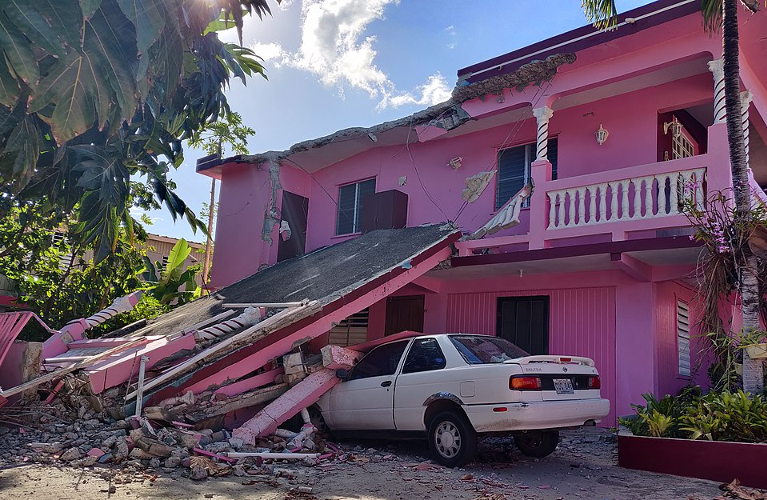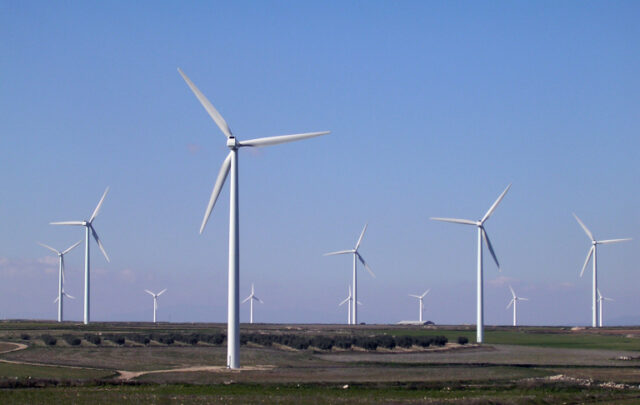Puerto Ricans were plunged in the dark once more in January, this time due to an earthquake that severely damaged a major power plant near the southern coast. Recurring tremors led to thousands sleeping in the open for weeks. The blackout, while temporary, was ominously reminiscent of the long blackout following Hurricane María two years ago, which left some residents without power for nearly a year. Once again the US territory’s indebted, poorly maintained, oil-dependent electric utility found itself in the headlines. The irony is that despite a great deal of rhetoric about renewables and hundreds of small solar projects since the hurricane, renewables still make up only 2.3% of Puerto Rico’s power (EIA 2019).
During research for a new documentary film on causes of the long blackout, “Dis.em.POWER.ed: Puerto Rico’s Perfect Storm” (with director Roque Nonini), we found that Puerto Rico’s transition away from fossil fuels is hampered by its ongoing “colonial” status, and a legacy of debt and corruption. The Puerto Rico Electric Power Authority, or PREPA, has long been a “piggy bank” for politicians and a pawn of Wall Street banks and oil companies. After US tax credits for manufacturers were phased out in 2006, leaving the island in economic crisis, predatory lending to PREPA for fuel credit lines and utility bonds persisted despite the territory’s mounting debt. High electric rates have heavily impacted residents, who faced more than a decade of austerity policies tied to the debt crisis and the 2006 phase out of US tax incentives for manufacturers in the territory. Today islander electricity costs more than twice the average on the US mainland (at one point during the high oil price years rates reached three-times the US average), while nearly half the population lives below the federal poverty line. Clearly, the potential for renewables depends on designing affordability into energy reforms.
The solar solution has long been touted on the island but never come to fruition. Shortly after we began filming in January 2018, San Juan’s Center for Investigative Journalism reported that roughly 1000 residents had filed complaints against Sunnova, a large Texas-based rooftop solar company, for overcharging (Martínez Mercado 2018). “We live in the tropics, we have sun 320 days per year,” said Luis Carlos Robles, manager of an island environmental justice non-profit, “but there are interests that work against (solar) . . . people who gain from keeping the status quo.”
Local critics recite a history of “green” scandals. The Sunnova case dates to 2011 when PREPA was paying over $100/barrel for oil and electric rates had soared. Both solar and gas were promoted as “green” choices by then Gov. Luis Fortuño (a neoliberal compatriot of recently ousted Gov. Ricardo Rosselló), who pushed through plans for 60 private renewable projects to take advantage of federal stimulus funds to aid recovery from the 2008 crisis. Fully 49 of the 60 projects were later cancelled due to poor planning and overpriced electricity. Even the ones funded had overpriced electricity, including the Sunnova project, which trapped homeowners renting solar panels into contracts based on high electric rates which did not adjust when oil prices fell in 2014 (Martínez Mercado 2018).
The Fortuño-era legacy of over-priced solar echoes what has been dubbed “green-grabbing” in other settings such as Spain ((Franquesa 2018) and Greece (Smith-Nonini 2020), where the goal of reducing carbon emissions has been used to justify dubious lending practices, land grabs for renewables, and the dismantling and privatization of public utility assets for private accumulation, ignoring ecological and social impacts. Even in a wealthy country like Germany, when a (highly democratic) reform initiative championed a transition to solar, there has been a backlash over resulting high utility rates that impacted all ratepayers (Oppenheim 2016).
Fortuño’s other (not-so) green boondoggle – which ran up over $100 million in new debt – was “Via Verde” (Green Way), a proposed 92-mile gas pipeline that would traverse fragile rainforest and wetlands, endangering the island’s fresh water supply. The key public benefit was to be lower electric rates, but a rising tide of environmental (and anti-austerity) protests stalled the plan. Then a nearly $10 million construction contract went to a childhood friend of the governor, and critics showed that electric rates would actually rise due to financing costs – leading to the project’s cancellation (eg. see: Peñalosa 2011).
The “greenwashing” of (fossil) investment strategies has been repeating post-María. Rosselló took advantage of the 2017 disaster to push forward a plan to privatize PREPA, and while the utility’s new Integrated Resource Plan includes centralized solar, it has become clear that the ruling party (pre and post-Rosselló) and PREPA officials are prioritizing investment in new gas infrastructure and importation of liquified natural gas (LNG) from the US mainland. The latest twist is a (sure to be controversial) plan for a LNG facility at the port of San Juan. Officials believe the Jones Act, a federal law requiring imports to arrive on US ships, will be waived so Texas fracked gas can be shipped to Puerto Rico [the US owns no oil tankers]. While gas emits less carbon than oil, methane emissions from fracking may make the fuel far more dangerous as a catalyst for near-term atmospheric heating than previously believed. Also, analysts at the Institute for Energy Economics and Financial Analysis (IEEFA), in Cleveland, Ohio, predict financing the gas plan would raise electric prices back to the levels of the Fortuño years, and costs for the new infrastructure would likely preclude spending on renewables during the lifetime of gas facilities (Sanzillo and Kunkel 2019).
Fortunately, there is another alternative. Dozens of public forums on energy after the blackout helped build momentum for a new law approved in April 2019 that incentivizes distributed solar and energy cooperatives. Last spring Casa Pueblo, a non-profit in the mountain town of Adjuntas, celebrated the town’s plan to install solar with donated funds to get off the unreliable grid entirely. But while solar prices have become far more competitive with fossil fuels in recent years, in Puerto Rico much will depend on rural communities and homeowners finding financing. Even before destruction from the hurricane (and the recent earthquake), islanders remain hamstrung by a decade of economic austerity, involving cuts in spending, pensions and jobs, due to the territory’s extended debt crisis.
The Trump Administration, however, has held back nearly all of $20 billion in federal recovery funds allocated by Congress, some of which would have assisted financing of rooftop solar, for most of 2019. Since the earthquake, the Administration agreed to release $16 million, but put in place restrictions against use of the funds for the electric grid. Another $2 billion Congress approved for updating the Puerto Rico grid is still being withheld by Washington (Fadulu and Walker 2020).
The federal intransigence over aid to help Puerto Rico become more sustainable reminded me of our filmed interview with Juan Rosario, an environmentalist and former public ombudsman on the PREPA board, who said, “The beauty of the new technology – solar panels, for example, is it can be very democratic. I don’t have to wait for someone to give me electricity, I can do that in my community by myself.” But he warned, “I don’t think (authorities) want that. They want to keep controlling the energy so they can keep controlling the people.”
The proposed Green New Deal emphasis on equity is a welcome counter-narrative to the hype and techno-fetishism that dominates so much environmentalist debate. Another of our film informants, Prof. Cecilio Ortiz García, co-founder of the National Institute of Energy and Island Sustainability (INESI) at the University of Puerto Rico -Mayagűez, warns “We are repeating a process where we buy into a belief that technological improvements bring about purpose, and it doesn’t work that way. We need to reflect on our purpose in society. What does sustainability mean for Puerto Rico? Instead of just concentrating on the next Tesla fad, or the next technical fix . . . what we need is innovation in governance of energy systems. We need people to come to the table and ask what kind of Puerto Rico we want in 20-30 years.”
Such an “energy systems” approach, for example, might elevate affordability and community/environment concerns, in debates currently dominated by difficult-to-quantify and abstract “emissions” (which oil and banking interests have learned to game). In Puerto Rico, for example, Marcel Castro-Sitiriche, a professor of electrical engineering at INESI, calculated that the most efficient use of federal aid for resiliency would be to put solar on houses of families in mountainous or remote towns at the ends of grid distribution networks (the last to have power restored in 2018!), rather than building gas plants (Castro-Sitiriche 2019). Given the widely cited truism of the Anthropocene that climate change will impact the poor far more than the privileged, such a plan to turn the tables and solarize those whom the grid has failed sounds sweet indeed.
References
Castro-Sitiriche, Marcel. 2019. Call to Action: Puerto Rico Energy Policy Brief. http://bit.ly/CHoLES and presentation on panel “Alternative Energy Disasters as Windows of Opportunity for Alternative Energy Pathways,” Resilience in Sustainable Reconstructino (RISE) Conference, 2019, State University of New York, Albany, NY, Nov. 19.
EIA 2019 Puerto Rico Territory Profile and Energy Analysis https://www.eia.gov/state/analysis.php?sid=RQ
Fadulu, Lola and Mark Walker 2020 “Trump Attaches Severe Restrictions to Puerto Rico’s Long-Delayed Disaster Aid” New York Times, Jan. 15. https://www.nytimes.com/2020/01/15/us/politics/trump-puerto-rico-disaster-aid.html
Franquesa, Jaume. 2018. Power Struggles: Dignity, Value, and the Renewable Energy Frontier in Spain. Bloomington: Indiana University Press.
Martínez Mercado, Eliván 2018. Privatization Fever with Renewable Energy Fails in Puerto Rico. Center for Investigative Reporting. Mar. 21. http://periodismoinvestigativo.com/2018/03/privatization-fever-with-renewable-energy-fails-in-puerto-rico/
Oppenheim, Jerrold 2016 “The United States Regulatory Compact and Energy Poverty,” Energy Research and Social Science 18: 96-108.
Peñalosa, Marisa 2011. Puerto Rican Governor Faces Opposition to Pipeline. Morning Edition. National Public Radio. Aug. 25.
Sanzillo, Tom and Cathy Kunkel. 2019. IEEFA update: Puerto Rico at a crossroads. Institute for Energy Economics and Financial Analysis, July 31.
Smith-Nonini, Sandy 2020 “The Debt/Energy Nexus behind Puerto Rico’s Long Blackout:
From Fossil Colonialism to “New” Energy Poverty,” Latin American Perspectives, forthcoming May.
Teaser photo credit: By maryamarce – Own work, CC BY-SA 4.0





